 |
|
|

BOOK SALE - I'm selling off some scholarly books via Amazon Marketplace. Have a look!

|
2006
November
28-30
|
A few notes
I'm busy and will go ahead and close out November with a few notes.
About spam:
Jeff Duntemann aptly points out that
the spam problem won't be solved until a sufficiently big,
powerful entity considers itself the victim.
Right now there's no single victim (corporation, cartel, industry, or government)
with the inclination and ability to wage war on spam.
He also points out that authenticating the source of e-mail won't help if the spam is being
distributed from virus-infected PCs. Each PC can identify itself truthfully and the spammer
has nothing to fear.
One thing that will help is software that notices when a new computer program is
connecting to the Internet and asks your permission.
Windows Vista includes this; so does F-Secure Client Security, which we use at work.
But the trouble is, entirely too many people automatically click "yes" to anything they
don't understand. The weak point in any computer system is the nut behind the keyboard.
I also think that many of the less sophisticated users
don't realize spam is wrong.
The radio and TV bombard them with commercials, so why shouldn't the e-mail?
Two related items:
A columnist opines that the computer-geek generation needs to
wake up and smell the copyright — that is, understand
that there is such a thing as intellectual property.
We are trying to persuade the entertainment industry to be more generous with various
kinds of "fair use" and personal copying.
Now is not the time to steal their stuff and republish it for profit.
And a news item shows that
people need to learn
that it's wrong to videotape people in private settings
(such as inside a classroom) and publish the videos.
Some things ought to be obvious...
But society went through this with 35-mm cameras in the 1930s.
At that time, though, the amateur could not singlehandedly publish to mass audiences.
Permanent link to this entry


|

|
2006
November
27
|
Congratulations, Cati!
Graduate student Cati Brown, a valued member of my research team and
co-author of several pieces of research,
is about to be a Ph.D.
She passed her thesis defense today and will turn in her dissertation in a few days.
Her dissertation was not actually part of the CASPR project.
It was directed by my colleague Don Rubin and is a study of the language of lying
in tobacco industry documents.
A sample of Cati's work is here.
People are just now realizing to what extent the tobacco industry
conspired to deceive
the public
(see also
this)
from about 1950 (when the health hazards of smoking were discovered)
until the 1960s (when people thought the hazards were first being discovered) and even later.
They set up fake research institutes, front organizations, misleading news releases...
all the tactics of a subversive organization.
And, as a side effect, they produced a huge collection of deceptive documents
for linguists to study.
Permanent link to this entry
The Internet is under attack and e-mail does not work reliably
I've had further e-mail problems which are directly traceable to the flood of spam currently
pervading the Internet.
Currently, 90% of all e-mail is spam, almost all of it
distributed through a small set of computer viruses.
CNN reports the basic facts, which I was already aware of.
These people are breaking numerous laws and need to be brought to justice.
I would even consider it a national security issue.
Think about it — as an act of sabotage, it's a big one.
The great resilience of the Internet is the only reason it hasn't had more impact.
We need both locksmiths and police.
Computer geeks only want to be locksmiths — and goodness knows the e-mail system
needs locks!
We need to end the current system, where any computer can, at no charge, place mail into
the system saying its point of origin is anything whatsoever.
We need to authenticate e-mail at the source and put a stop to floods of spam
anywhere they can be detected.
And we also need to catch the varmints and make 'em wish they hadn't done it.
They're guilty of millions of counts of spamming, computer trespass (viruses),
and fraudulent advertising.
Spamming will end when a substantial number of spammers are in jail.
A third thing we must do is persuade the public not to buy from spammers.
Somebody must be paying money for all those misspelled pharmaceuticals, or the advertisers
wouldn't keep advertising them. Do the buyers realize the products are likely to be fake?
Permanent link to this entry
Where to buy a refurbished Canon
For a brief moment last night I thought I had snared a
refurbished Canon EOS 20Da.
That's Canon's special astronomical DSLR.
I couldn't afford one while it was on the market; now it's sold out and has not been replaced.
Adorama in New York had some refurbished 20Da's at a price even I could afford, but they
sold out before I got to them.
Along the way I learned that a substantial number of refurbished-by-Canon DSLRs are coming
onto the market at very affordable prices.
Two places to buy them are
Adorama
and
RefurbDepot.com.
Click on the links.
Permanent link to this entry
Mystery goo confirmed
Melody went to
Bounty's web site
and confirmed that paper towels contain "resin."
That probably explains why the windshield got streakier the longer I rubbed it
with paper towels.
Several people wrote in to confirm that cloth towels work better,
and that you have to apply plenty of pressure because the scum is not dissolved,
just softened up a bit, so you still have to rub it off the glass.
Permanent link to this entry


|

|
2006
November
26
|
Do paper towels contain mystery goo?
A note on cleaning windshields
For several days Sharon and I have been trying to clean the insides of the windshields
of two cars. I say trying because our attempts haven't been successful.
We were using paper towels with both Windex and a vinegar-based cleaner, and each time,
it seemed impossible to get the windshields clean.
As you know, the gray scum that accumulates inside a windshield is actually plastic.
It consists of molecules that have escaped from plastic in the car, traveled through
the air, and redeposited on the glass.
This stuff doesn't actually dissolve in any cleaner that's safe to use in the car.
All you can do is soften it up and wipe it off.
Well... That's the theory, and it just didn't work. Wet or dry,
our paper towels seemed to deposit
as much scum as they removed.
Today I had one last go at it, and on a whim, I brought along some freshly-laundered
white terrycloth towels. Voilà — the cleaning wasn't effortless, but it went
a lot better than with paper towels.
My theory? Paper towels contain mystery goo. That is, they contain some kind of
plastic or wax to strengthen them, and it deposits on the windshield.
After all, strength while wet is a selling point
of paper towels.
Can anyone tell me more about this?
Permanent link to this entry


|

|
2006
November
25
|
Miscellany
Anniversary:
As I write this, it's 31 years, almost to the minute,
since I met Melody.
And this July we will have been married 25 years.
I'm ready for 2500 more, at least.
Nikon lens: Does anybody want to buy my
Nikon 180/2.8 ED AF-D telephoto lens?
As you can see from
Nikon's data sheet,
it's a superb lens, but I no longer use it much.
Mine is in pristine condition, with original box and leather case, and I'll
probably list it for about $595 on Amazon Marketplace. It lists for $1049 new.
How many Thanksgiving dinners include a visit to a 5-axis milling machine?
Ours did; it belongs to Melody's uncle, Warren Barnett, who uses it to customize cylinder heads
for race cars. (At the moment, his web site
appears to be down.) His warehouse and machine shop are across the street from his home,
and a number of us got a tour. Impressive machine... and it's all done with matrix arithmetic.
I think that now that audio, photography, and video have been digitized, the next computer
revolution will be CAM in every workshop. Imagine having a machine in your home that
could make virtually anything out of wood, plastic, or soft metal on short notice.
Anything from a new handle for the faucet to a new set of napkin rings for the dinner table
(from a design you just downloaded). Think what a creative outlet it might be, particularly
when people share their designs rather than just designing everything for themselves.
And that's assuming all you do is mill a chunk of one material.
What if you could construct things atom by atom?
Read this
for one MIT professor's prognostications.
Permanent link to this entry


|

|
2006
November
24
|
Are you getting all your e-mail?
Revised November 25.
I wasn't; I discovered today that important messages, including some from my dear wife,
were being set aside as spam.
The current firestorm of spam has made it harder for ISPs to distinguish junk mail from
important e-mail. I cleaned out my junk mail folder and found several important
messages I'd been
waiting for.
Why do we have a spam problem? In my opinion, mainly because existing laws aren't being
enforced. And I don't just mean the CAN-SPAM Act. Almost all spammers are violating
pre-existing fraud laws of one kind or another.
Plenty of them claim to be selling prescription drugs illegally.
Others are manipulating the stock market.
And why aren't the laws enforced?
Because the Internet doesn't pay taxes.
There's strong sentiment that the Internet should be a tax-free zone
(and almost a law-free zone).
The Internet is a new part of society, but it produces no direct revenue,
so there is no money to pay for new government services there.
The Internet is flawed both technically and culturally.
Technically, because it doesn't impose costs on the people who choose to consume
resources, such as senders of e-mail.
Culturally, because of a frontier mentality.
On the wild frontier, only the strong are safe, and many of them look down on the weak.
Am I describing western gunslingers or computer geeks? Both!
Notice how quickly computer experts want to blame the victim whenever anything goes wrong.
"You're not as strong as me, so you deserve what you get."
I think there's a further problem.
Nobody talks about it, but there's a strong pornography subculture on the Internet,
and that's probably why we hear such loud opposition
whenever anybody wants to make Internet users more accountable.
Even if pornography is legal, people are ashamed of it,
and that's why they don't want anybody to know where they've been.
Privacy is valuable, but your right to privacy ends when you
send a file to my computer.
I think people should be able to surf the Web anonymously
and send e-mail anonymously (which is sometimes the only way
to blow the whistle on misdeeds or ask for
certain kinds of personal advice).
But anonymous communication should be labeled as anonymous.
Making up and using false names at random is not acceptable.
I'm tired of this "electronic frontier."
Let's have some civilization.
Permanent link to this entry


|

|
2006
November
23
|
Happy Thanksgiving!
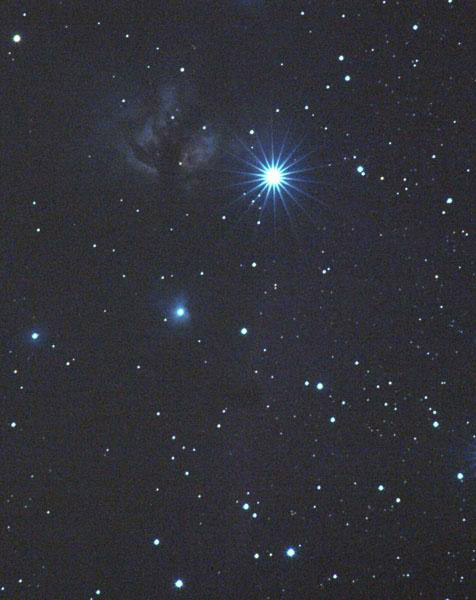
Color-corrected picture posted December 20.
No, that's not a picture of a turkey. It's the region of the star Zeta Orionis,
including several nebulae. I meant to blog this picture several days ago but overlooked it...
We do have plenty to be thankful for. Melody and I are prosperous and productively occupied;
both of our children have reached adulthood;
and November 25 will be the 31st anniversary of the day we met.
I'm busy with several things and may not post much here for several more days.
Happy Thanksgiving!
Permanent link to this entry


|

|
2006
November
22
|
Some etymologies
Modern business jargon is full of phrases such as "pushing the envelope" and
"in the loop" that are used by people who don't know what they originally meant.
This surely leads to confusion. So today I'm going to try to dispel some of the mystery.
"Pushing the envelope"
To push the envelope is to do something daring, close to the limits, but it has
nothing to do with sliding a paper wrapper across your desk.
In engineering, an envelope is an enclosed region on a graph (in 2 or more
dimensions). Consider for example the RPM and permissible load on an engine.
Plot them against each other, and there is a region on the graph in which the engine
operates reliably. This is the safe operating area (SOA) or "envelope."
To "push the envelope" is to operate at the edge of that region — maximum speed,
maximum load, or both — that is, to push against at least one limitation, maybe several.
Permanent link to this entry
"In the loop"
I suppose some people think in the loop refers to trains in Chicago,
or maybe the Washington beltway. But it actually comes from control theory.
Consider a heater controlled by a thermostat. There is a closed loop consisting
of the thermostat, the heating element, and the temperature of the air. Each of these
has an effect on the next one, and that's why the thermostat works: indirectly, through
the heating element and the air, the thermostat affects itself.
Some management systems are a bit like closed loops, if the boss is expecting feedback
(another control theory term!) from the subordinates. You are "in the loop" if you are
part of such a system, where proposals are sent down to you and you pass them along in such a way
that your response will eventually get back to the source.
Permanent link to this entry
"Nest egg"
Investors refer to almost any kind of initial investment as a nest egg.
That's not quite what the term means to a poultry farmer.
A "nest egg" is an egg (real or artificial) that is left in the nest to encourage
the hen to sit there and keep laying more eggs.
So, in investing, nest egg should refer to a part of the investment that will never be
liquidated. Some people use it with that precise meaning, and some don't.
Permanent link to this entry


|

|
2006
November
21
|
Notes from all over
Don't burn down your house with a turkey fryer.
A hot cookpot full of flammable oil is an incendiary device.
See scary photos and other advice
here.
Christian Buil has tested the Digital
Rebel XT versus XTi for astrophotography.
In France they are known as 350D and 400D. Yes, the test report is written in French.
No, that doesn't keep me from reading it.
He found more hot pixels on the XTi than the XT. I think that's a matter of luck;
his XT is a peach.
What every darkroom needs: Corning
media
storage bottles. ("Media" are liquids for growing microorganisms; labs need good, resealable,
durable bottles to store the prepared media and keep the microorganisms from getting in before they're wanted.)
I bought a couple of these on eBay last month and am finding them very handy.
They are made of thick Pyrex and are tough.
Note the brown low-actinic version (good for developer), and also the space-saving square ones.
Speaking of glassware, here's a
museum of cathode-ray tubes
and other "electronic glassware."
And guess what?
If you don't want to buy Windows XP with a new laptop,
you don't have to.
Someone actually claimed, and got, a refund for not activating Windows on a laptop.
Permanent link to this entry


|

|
2006
November
20
|
Coins and other matters
You'd think the
U.S. Mint
reads
this blog.
They're bringing out a new set of dollar coins
with the presidents' faces on them — politically neutral
because it includes all of them.
Speaking of faces, I think the American who most deserves to be honored on coins or currency
is Thomas Edison.
If your life hasn't been impacted by electric lights and recorded music,
you must live in a cave.
In other news, happy 18th birthday, Sharon!
I no longer have any children. All four inhabitants of this house
are now legal adults.
Permanent link to this entry


|

|
2006
November
19
|
Canon Digital Rebel XTi (400D) under the stars
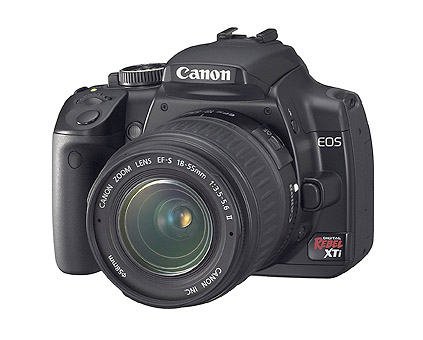
Canon USA press photo
Last night, under somewhat mediocre conditions, I did my first astrophotography
with the
Canon Digital Rebel XTi (EOS 400D)
that Canon has lent me.
It's a good camera. Relative to the Digital Rebel (300D), it adds, among other things,
in-camera dark-frame subtraction (noise reduction), mirror lock, and a new, larger
LCD screen that displays camera settings as well as pictures.
I believe the first two of these features are also on the Digital Rebel XT (350D).

Orion Nebula (M42) Copyright 2006 Michael A. Covington
For easy astrophotography, this camera is a winner.
Above you see a single 3-minute exposure at ISO 200, f/5.6, using a Nikon 300/4 lens
with a Fotodiox adapter, the whole thing piggybacked on a guided telescope.
No special software was needed to process it — I just did standard
Photoshop things, including some unsharp masking as well as cropping and contrast
adjustment. You are looking at a small part of the 10-megapixel image.
One of the handiest features is that during a time exposure, the elapsed time
shows up on the LCD, so you can just watch the clock.
A drawback is that this camera emits rather a lot of light — from the LCD display
of settings and the power-on LED on top — but the LCD can be turned off and you
can put a piece of tape over the LED.
I don't have any rigorous test results yet.
The first obstacle I ran into is that the XTi introduces a new version of Canon's
.CR2 raw file format, and my software (Adobe Photoshop CS2, Microsoft Raw Image Previewer,
and most crucially MaxIm DL) didn't support it (even though some of these packages
support the .CR2 files of earlier Canons).
For Photoshop, a Camera Raw upgrade has been released but Adobe's web site is malfunctioning
and I couldn't get it; I finally found it at
www.download.com, a reliable site maintained by CNET to
mirror manufacturers' downloads.
The MaxIm DL people were kind enough to send me (in the middle of the night!)
a beta version that works fine. Soon it will be released as an upgrade.
For the Microsoft product, there's probably no hope until we switch to Windows Vista.
There is a game going on because Canon doesn't release the details of the raw
file format; that would tell their competitors
too much about how the camera works.
Instead, they leave it to Adobe, MaxIm DL, and others to reverse-engineer
it for themselves. I need to do a bit of this myself for
EXIFLOG,
my free utility that looks at a set of image files
and outputs a checklist of basic data on a text file, for use in a logbook.
I'm going to start with
this set of
notes about the earlier .CRW format; it's part of the web site for
Phil Harvey's EXIFTOOL,
which is like EXIFLOG but more powerful and written in Perl.
Permanent link to this entry


|

|
2006
November
18
|
Rethinking our coinage
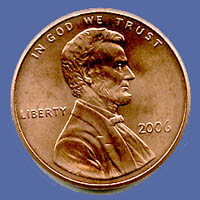 Abolish the penny?
Yes, please! It's been obsolete for half a century.
Keep it around in small quantities for people who want it, but pass a law allowing all cash
transactions to be rounded to the nearest 5 cents.
Lots of other countries have done similar things.
Today's dime, not penny, is worth what the half-cent was worth when we
discontinued half-cent pieces in 1857.
Abolish the penny?
Yes, please! It's been obsolete for half a century.
Keep it around in small quantities for people who want it, but pass a law allowing all cash
transactions to be rounded to the nearest 5 cents.
Lots of other countries have done similar things.
Today's dime, not penny, is worth what the half-cent was worth when we
discontinued half-cent pieces in 1857.
Two economists debate the issue
here.
People are afraid that all prices will rise when they get rounded to the nearest five cents
(e.g., $1.98 to $2.00). But this is a small fraction of the price,
and experiments in other countries has shown that it doesn't happen.
In the U.S., sales taxes should more or less insulate us from it; the price advertised
as $1.98 actually comes out to $2.12 if you have a 7% tax, and then it rounds down to $2.10, not up.
Foreigners are probably bemused by two facts about American coins: they don't have numbers
on them
(quick, is a "quarter dollar" more like a farthing or a shilling?)
and we don't use all the denominations.
The 50-cent piece
stopped circulating rather abruptly around 1964 for two reasons.
First, vending machines don't take it; and second, people started viewing it as a commemorative
for Kennedy rather than as money.
It is one of our best-designed coins, based on Kennedy's inauguration medal,
but Kennedy's face was put on it very soon after the assassination, while his legislative
package was still before Congress.
So Democrats viewed the coin as too sacred to spend, and Republicans viewed it as
a campaign token.
As a boy, I actually heard rumors that the Kennedy coins weren't legal tender, or, conversely, that
they were all soon going to be valuable and we should hoard them
(perhaps because, for a few years after 1965, they were the only U.S. coins that still
contained silver).
Another coin that probably failed for political reasons was the
Susan B. Anthony dollar.
It had a design problem too — it looked way too much like a quarter.
But I think a good many people viewed it as a campaign piece for
the Equal Rights Amendment,
which never passed because people were afraid of what a highly activist Supreme Court
would make of it. (Would the army have to draft women?)
In my opinion, a more explicit amendment granting equal rights to women,
spelling out more details, would have passed.
Also, some of us, initially inclined to support the amendment, were put off by the last-minute
attempt to extend
the deadline for ratification — which looked like gerrymandering in the time dimension —
and I gather that some people felt that the Anthony dollar was yet another last-ditch campaign move for it.
Today we have the
Sacagawea dollar,
which looks distinctive enough; it's immensely popular in
South America (where U.S. currency circulates) but not in the U.S. itself.
I think we need to use a dollar coin, and the way to do it is to create a shortage of dollar bills.
Not discontinue them altogether, but make them harder to get, to encourage the use of a dollar coin
instead. People will not change the way they're doing things until they have an incentive.
I suppose some people view the Sacagawea dollar as a token of political correctness
(a female and an ethnic minority at the same time!).
This may work for it or against it.
There's a lot to be said for going back to purely national symbols on coins,
devoid of political significance.
Cathy tells me the system I describe is what circulates in Ecuador, which uses U.S. currency as well
as locally minted coins of the same sizes: Few pennies, lots of 50-cent pieces and Sacagawea dollars.
Ecuador adopted U.S. currency only a few years ago and has no traditions to get in the way of
practicality.
Permanent link to this entry
Nikon Coolscan III LS-30 under Windows XP
For Windows Vista instructions,
which may also be relevant to Windows XP,
click here.
Yesterday's pictures were put here by digitizing the negatives in my
Nikon Coolscan III and then "making the print" with Photoshop.
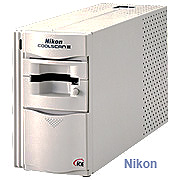 This particular Coolscan is a SCSI device and is a bit tricky to get working
under Windows XP.
Here's what I know...
This particular Coolscan is a SCSI device and is a bit tricky to get working
under Windows XP.
Here's what I know...
(1) You need an ASPI driver for your SCSI card, or else it doesn't work. Specifically, ASPI
version 4.7, free from www.adaptec.com,
is recommended. (Nikon knows this
much.) ASPI is one of several ways for the operating system to communicate with SCSI devices.
(2) You need Nikon Scan 3.1.2 (downloadable from Nikon); other versions won't do.
(4) If you normally keep the scanner turned off, here's what to do when you turn it on:
either reboot, or right-click on My Computer, choose Manage, right-click on almost any node,
and choose "Scan for Hardware Changes." This will start the scanner.
(4) The scanner does not need a driver in order to work, and Nikon does not provide one.
But Windows is implacable! It will keep saying "Found New Hardware" every time you turn the scanner on.
The solution is to install the LS-2000 driver. Specifically, when Windows asks for a driver,
point it to subfolder INF\LS2000\WinXP in the folder where you unpacked Nikon Scan 3.1.2.
The two files there, NKSCNUSD.DLL and NKscnXP.INF, actually pertain to
both the LS-2000 and the LS-30. You can verify this by reading the .INF file
in a text editor.
I figured this out by reading the .INF files.
Since then,
Nikon has published a document
addressing this problem.
It refers to a downloaded file called nsinfxp.exe, which I can't find anywhere on Nikon's site.
Presumably, it contains the two files you need.
Why does Windows XP want a driver when Windows 2000 didn't?
Because Windows XP keeps track of scanners and cameras for itself rather than leaving
the whole job to your software.
And it is true that NKSCNUSD.DLL is something of a do-nothing driver.
It does not actually enable Windows to use the scanner; you still need Nikon Scan
or Vuescan.
With newer scanners, if you go to Control Panel, Scanners and Cameras,
and double-click on the scanner, you get the Windows Scanner Wizard.
With the Coolpix III, you only get a Properties box.
While you're at it, check the firmware version of your Coolscan III
here.
Bizarrely, Nikon says the firmware updater can't be run under Windows XP.
I'm skeptical about that; the Windows 2000 version should work just fine,
but I haven't tried it. Fortunately, my firmware is up to date (1.31).
Permanent link to this entry


|

|
2006
November
17
|
Old cameras still take pictures
The Voigtländer Vito B and
Olympus OM-1 recently depicted here
are still in good working order.
I loaded each of them with Fuji Neopan 400 and tried them out.
The first picture here was taken with the Olympus,
the second with the Voigtländer.

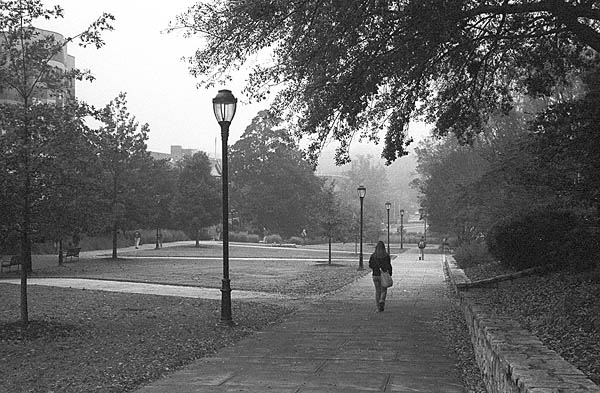
The second picture actually shows some of the newest landscape architecture
on the University of Georgia campus, if you can believe it.
Since 1990 or so, traditional architecture has come back into fashion,
and so have elegant lampposts
that direct their light toward the ground instead of the sky.
Permanent link to this entry


|

|
2006
November
16
|
Milton Friedman, 1912-2006
Today we mourn one of the most influential thinkers of 20th-century America,
the economist who led the movement which gradually convinced politicians and
voters that the economy should not be centrally planned or controlled.
He was also the strongest proponent of
controlling inflation by controlling the money supply,
a strategy that has been put to good use since 1980, ending the Great Inflation
of the mid-20th Century.
The key idea is that the government shouldn't print money indiscriminately;
its job is to match the supply of money to the supply of goods and services.
Remember President Ford's "Whip Inflation Now" campaign and the TV spots
about how inflation was caused by people being "piggy"?
That is what inflation control was like before our leaders
listened to Friedman.
Silly, wasn't it?
See also Greg
Mankiw's blog entry.
Permanent link to this entry
DSLR price war?
The astute reader will have gathered that I'm keeping up with DSLR camera technology
in preparation for a book project. So here's today's news from the world of DSLRs...
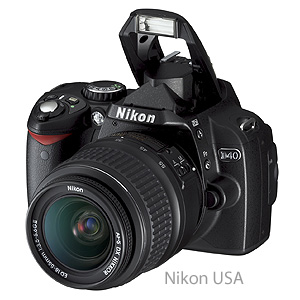 Today Nikon surprised the world by introducing a new, low-priced DSLR camera,
the D40, which will sell for under $600 with lens.
It will be available by mid-December.
Today Nikon surprised the world by introducing a new, low-priced DSLR camera,
the D40, which will sell for under $600 with lens.
It will be available by mid-December.
This puts Nikon's arch-competitor Canon in a tight spot.
Canon's entry level DSLR has been upgraded from Digital Rebel to Digital Rebel XT and XTi,
each with higher performance, but the price has slid up too.
The XTi sells for just under $900 with lens, and it looks as if Canon will lose the low-end
market unless they do some price cutting quickly.
The D40 is designed to look like a Canon XTi at first glance. Like the XTi, it has a large
2.5-inch LCD screen and no other LCD. Gone is the gray panel that used to show the shutter
speed and aperture.
Internally, the D40 is a considerably lower-performance camera than the XTi; it's only 6 megapixels
and only works with a few of the latest-model Nikon autofocus lenses.
Currently, the least expensive DSLR is the Pentax K110D, just under $550. Nikon may not match that,
but they have a bit more name recognition.
Meanwhile, Wolf Camera is going to sell Nikon N75QD film SLRs for $150 to the first 20 customers
who show up at their Buckhead store each day from tomorrow to Sunday.
I think the bottom is falling out of the market for film cameras.
They almost can't give them away.
Permanent link to this entry


|

|
2006
November
15
|
Lens mount adapters for the Canon EOS
I am happy to report that the
Fotodiox adapter to put
Olympus OM lenses on a Canon EOS
works very well. It holds the lenses perfectly steady and is each to
attach and remove.
The same is true for their adapter for the M42 screw mount.
Incidentally, this is the longest-lived lens mount in the business;
it originated with Contax in 1949, became the Praktica-Pentax standard,
stayed in production on Zenit
cameras in Russia until 2005; and
is still used on the Voigtländer Bessaflex,
a high-tech living antique marketed to people who prefer older cameras.
Fotodiox's "pro-grade" Nikon lens to EOS body adapter is better
than most, but no Nikon-to-EOS adapter is perfect.
The reason is that the Nikon lens mount contains springs.
Inside a Nikon body there is room for strong leaf springs made of steel.
Not so in an adapter whose thickness is limited to 2.5 mm.
The adapter has to rely on flexure of tabs that protrude from the same
piece of metal that constitutes the lens mount itself.
It is easy to make them too weak or too brittle. So although both
of Fotodiox's Nikon-to-EOS adapters are usable, neither one is as
sturdy as the other kinds of adapters.
Permanent link to this entry


|

|
2006
November
14
|
What were they thinking?
Today's dubious achievement awards:
(1) To the makers of the movie Borat
for insulting a real country (Kazakhstan) and for
tricking
people into appearing in their movie
for very little pay and subjecting them to unexpected humiliation and embarrassment.
(2) To Sir Elton John
for advocating a ban on organized religion.
You heard that right — on this point Sir Elton talks as if he sees eye-to-eye with Stalin.
Or maybe he's following in the footsteps of
Linda Ronstadt,
who told the press she didn't want "Republicans or fundamental Christians" in the
audience at her concerts.
As I've said before, toleration is one of several human activities where the people talking about it
aren't the people doing it!
Revised for conciseness on November 15.
Permanent link to this entry
More pictures from last night
More of last night's catch... Here's the Double Cluster in Perseus
(NGC 869 and 884), a stack of 3-minute exposures with a Nikon 300-mm lens
on a Canon Digital Rebel body.
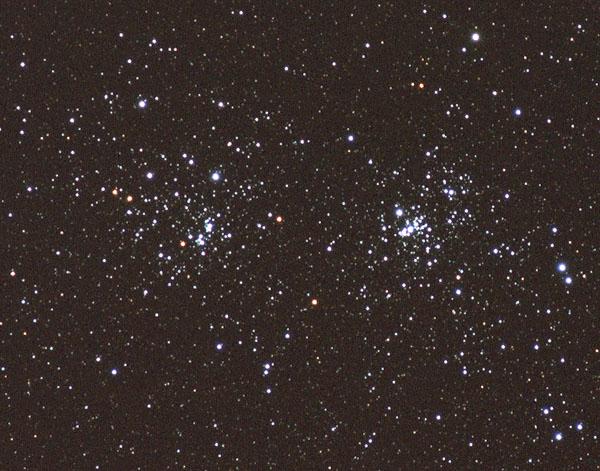
Color-corrected picture posted December 20.
And here's yet another picture of the Pleiades
(my favorite star cluster)
showing some of the reflection
nebulosity (dust clouds). This was taken with the same setup as
the preceding. Both were taken in Athens, Georgia, under skies where the
naked-eye limiting magnitude was 4.5.

Color-corrected picture posted December 20.
Permanent link to this entry


|

|
2006
November
13
|
Nikon D50 vs. Canon Digital Rebel for astrophotography
Last night I did a lot of astrophotography, but the pictures of most interest to
the technorati will be this comparison.
I photographed the galaxy M33 with the same Nikon 300-mm lens at f/8 with
Cathy's Nikon D50 and my Canon Digital Rebel.
(Yes, f/8, to eliminate focusing errors and to simulate a much fainter object in a darker sky.)
Each of the following pictures is a stack of two 3-minute exposures at ISO 400, with
dark frames subtracted. They were processed with MaxIm DL and Photoshop to look as
much alike as possible. The Nikon was used in Mode 3 ("star eater"
disabled by
powering off the camera during the dark frame exposure).
What matters is how many stars and other celestial objects you can see in the picture,
and as should be evident, there's very little difference.
Compare to a map of M33 and NGC 604
and you'll see that there are some
hydrogen nebulae in the picture, though they came out bluish rather than red.
Canon definitely wins on ease of use because there's no "star eater" and hence
no need to turn the camera off during the session, losing some settings each time.
But if you need a Nikon for other reasons, rest assured that it's quite usable for astronomy.

Color-corrected picture posted December 20.
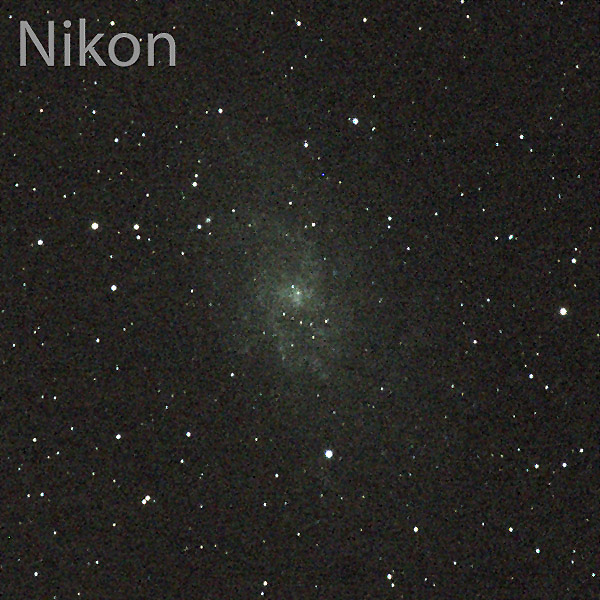
Permanent link to this entry


|

|
2006
November
12
|
Beware of blogs? You don't know who's behind them
In the medical journal The Lancet
(Nov. 11, 2007, pp. 1641-1642; not available free on line),
Ivan Oransky points out that
unlike professional journalists or scientists, bloggers have never been told not to take kickbacks
and we will probably see an increasing number of blogs that are covertly funded by
companies or organizations.
Fake blogs ("flogs") have already appeared; there was, for instance, a pro-Wal-Mart blog
secretly and indirectly funded by Wal-Mart.
On a lower level, there may be any number of blogs recommending products because the blogger
got freebies from the company. This is apparently starting to be a problem in
diabetes support groups and the like.
I hasten to add that I don't normally get free products to
review, other than books or small amounts of consumable supplies,
and when I do, I'll mention it if I mention the product here.
For instance, I recently tried out a Nikon D80 courtesy of Nikon USA, but then I had to give it
back to them.
But on the other hand... Blogs have injected a great deal of much-needed freedom and efficiency
into journalism. Professional journalists may be constrained not only by ethics but also by the
wishes of their own publishers. Bloggers run free.
Permanent link to this entry


|

|
2006
November
10-11
|
Veterans' Day
Happy Armistice Day!
I recently told my daughters:
You are descended from a long line of brave men.
Your father survived Yale Graduate School.
Your grandfather won a Distinguished Flying Cross in World War II.
And your great-grandfather [Charles Covington, 1898-1973]
was so tough that on the day he was drafted for World War I,
the Germans gave in and signed the armistice!
Permanent link to this entry
I pledge allegiance...
Why did this make the news?
A student organization
stopped
reciting the Pledge of Allegiance at meetings.
As Garfield would say, "Big fat hairy deal."
Their meetings have basically nothing to do with U.S. citizenship,
so why do they need to start out by declaring their loyalty?
Foreigners think it funny that we have schoolchildren recite
the Pledge every day (or used to)
and begin many kinds of meetings with it.
It's the sort of thing that belongs in a ceremony for naturalizing
new citizens, and maybe things like the opening of Congress and the courts, but
I don't think people are "anti-American" if they don't want to recite
it repeatedly in everyday life.
Permanent link to this entry
None dare call it Christmas?
Minor revisions November 12 and 15.
Wal-Mart and Macy's have decided that
Christmas
will be called Christmas this year.
I had my say about this issue
last year
(see also
this).
I have no objection to being wished a merry Christmas or happy holidays.
Nor do I think anybody is likely to take offense at either one.
But the practice of deliberately suppressing the name "Christmas," while
continuing to celebrate exactly the same holiday,
looks like an anti-Christian gesture.
I'm glad to see that this fad has ended.
Permanent link to this entry


|

|
2006
November
9
|
Adobe Illustrator CS2 in slow motion
Symptom: Adobe Illustrator CS2 responds to all actions very slowly;
even nudging an object a short distance with an arrow key takes several seconds.
This occurs when Illustrator was launched by clicking on a file that is on a networked drive.
Solution:
Tell Illustrator to use C: rather than "Startup" as its scratch disk.
The appropriate setting is under Edit, Preferences, Plug-Ins & Scratch Disks:
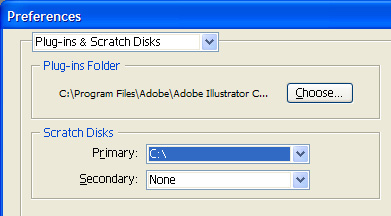
This problem showed up at the lab today while I was (of course) working in a great hurry.
Permanent link to this entry
Pest of the day
Even with the election over, and all this going on,
and even though we're on the Do-Not-Call List,
the Democrats, or somebody claiming to be the Democrats, phoned us during dinner.
Non-profit organizations are exempt from the Do-Not-Call law. They shouldn't be.
Permanent link to this entry


|

|
2006
November
8
|
Miscellany
Because of clouds, I didn't get to watch the
transit of Mercury today. Did you?
(Technically, as I write this, it's still going on, but visible only from places where
the sun hasn't set yet.)
Someone has made
a web page
about the experience of shopping at
Apex Electronics, a surplus store in Burbank.
Melody and I went there once as newlyweds (24 years ago) when I was looking for an isolation transformer.
The place obviously hasn't changed much, except that all the encrustations are thicker.
Odd economic statistic of the day:
The demand for $2 bills is up.
Nobody knows why.
Permanent link to this entry


|

|
2006
November
7
|
So were those phone calls fake?
Maybe some of those automated phone calls from political candidates
weren't really from the candidates' campaigns!
A few might have been from third parties or even from the candidates' opponents, trying to
give a candidate a reputation for telephone harassment.
At least, that possibility is today's political scandal, dwarfing even the issue of
electronic voting machines.
Google for "robocalls"
or check out this report,
or this one, to pick a couple at random.
My solution? Ban all automated calling for political campaigns or any other purpose.
Then warn people not to trust such calls if they get them.
Permanent link to this entry


|

|
2006
November
6
|
Don't vote for Jane Kidd
IMPORTANT: See also November 7.
I know nothing about Ms. Kidd except that her campaign has made at least 4
phone calls to my home in the past few days, and at least one to Cathy's cell phone.
At least half of these were from automated dialers playing recorded messages.
All told, we've had over 20 calls from campaigns, some of which failed to deliver any
sound at all — they just dialed us up (usually with concaled Caller ID data)
and the line went dead.
Any politician who campaigns this way is rude and will not get my vote or endorsement.
We need to close the loophole that allows non-profit organizations to use autodialers
that play recordings.
If, indeed, it's legal now — it may not be.
Look carefully at
the current law.
Apparently, 47 USC 227 (b)(2)(B)(i) is the loophole the callers are relying on.
But (b)(3)(A)(i) apparently makes these calls illegal if the machine does not actually play the
recording! It is then an unidentified phone soliciation.
Revised for conciseness November 15.
Permanent link to this entry


|

|
2006
November
5
|
Olympus OM-1
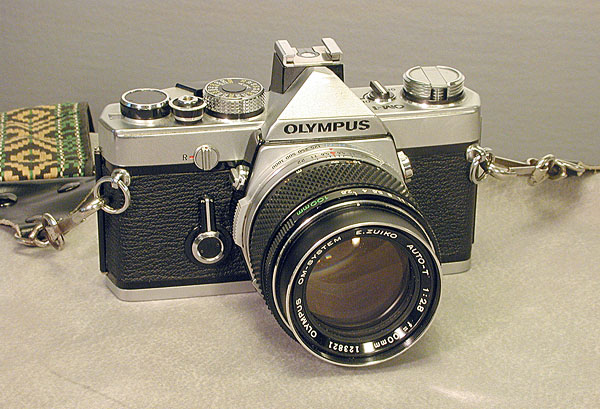
Camera buffs are apparently flocking to this web site to see the
old Voigtländer, so let me present another historic
camera (historic for me, that is) — the Olympus OM-1, which I bought in 1976 and used
intensively for more than 20 years, and which is still in good working order,
although, as you can see, it has taken a knock on the head
(apparently affecting only the cover, not what's inside).
There's a tremendous number of Olympus OM series web sites
such as this one,
and at least one fan site for its designer
(here).
For OM-series repairs let me recommend
John Hermanson.
In the picture you see the second lens I bought for the Olympus, the
100-mm f/2.8,
a 5-element design derived from the Zeiss Sonnar, but very original.
In place of the Sonnar's thick, heavy middle element, it has two light ones,
making it the smallest and lightest telephoto lens anyone had ever seen at the
time it came out.
Permanent link to this entry


|

|
2006
November
3-4
|
An unusual use for a table saw
Our bank has changed one of its routing numbers, and we have to destroy all our old checks
and use new ones.
The pads of unused checks are too big to feed into the shredder conveniently.
So I used my table saw (and sliding cutoff box)
to saw them in half as if they were small pieces of wood.
The result was quick and neat, and the saw took out a swath wide enough that
nobody can just tape the halves of a check
back together.
But to keep anyone from trying, I'm throwing the halves apart separately so that
they will go to the landfill on different days.
Permanent link to this entry


|

|
2006
November
2
|
Telecentricity
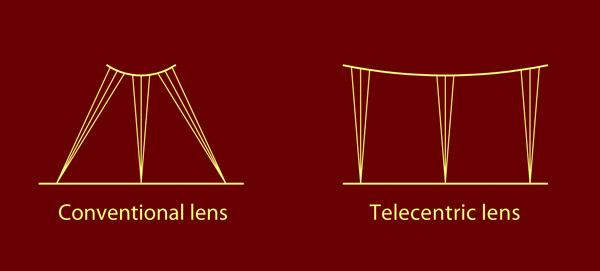
Here's a bit of optical technology that most reference books don't cover well.
A telecentric lens is one
where the light for all parts of the image travels
in the same direction (or, equivalently, one whose entrance and exit pupils are
infinitely far away).
Until recently, they were just a mathematical curiosity. But now they have some
practical uses.
Lenses that are telecentric on the object side are used in machine vision because
they produce images with very simple, constant perspective, like the flattened perspective
that you see through binoculars or a telescope.
Details here
and here.
Lenses that are telecentric on the image side are in demand for digital cameras.
As you see in the diagram above, a telecentric lens makes the light rays hit the sensor straight-on.
The rays from a conventional lens are straight-on only in the center;
at the edges, they hit the sensor obliquely, causing color fringing.
This is of interest to DSLR astrophotographers like me, of course.
As the diagram indicates, the rear element of a image-telecentric lens has to be rather
large in diameter.
So does the lens mount.
This is a good reason not to use full-size 35-mm sensors in DSLRs.
In fact, one of the design goals of the Olympus 4/3 System was to have the sensor
smaller than the lens mount so that telecentric lenses can be used.
Another advantage of telecentric lenses is that the magnification doesn't change with
small changes in focus (as it does with a conventional lens).
This interests astronomers who may be stacking multiple images and can't guarantee
that they are all focused exactly alike.
A digital camera lens need not be, and generally is not, perfectly telecentric.
But some are closer than others.
A large rear element is a good sign (look at
this
Sigma design for example).
Telescopes and long telephoto lenses are always fairly close to telecentricity just because
they are so long.
Permanent link to this entry
Camera accessory of the day
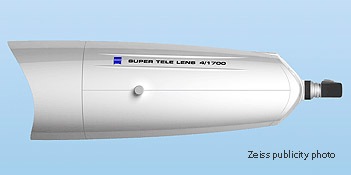
Camera accessory of the day:
this 1700-mm
f/4 Apo-Sonnar for Hasselblad,
custom-built by Zeiss for a rich eccentric.
I have no idea how much it cost, nor how well it will work.
It's for wildlife photography. The trouble is, the weakest optical element in that situation is usually
the air itself, which will blur the image more than even a cheap lens would.
Now if you could aim it off a cliff, or up into the sky, you'd get somewhere.
In fact it's almost certainly a remake of a secret military lens (for photographing aircraft or
satellites).
Instead of that Hasselblad, I'd use a
good sub-35-mm DSLR
with a lens like
this one.
Not Zeiss, but good performance
for the price of a car rather than the price of a chateau.
Permanent link to this entry
Miscellany
If you like optical illusions (with explanations), check out
Donald Simanek's collection.
The world is almost down to one lab that processes Kodachrome,
and it isn't run by Kodak. (There's one still hanging on in Japan, and it isn't run by Kodak either.)
Speaking of photo labs,
Film Rescue International is the place to get film developed
if you just found it in Granny's camera and it's a format last made 30 years ago.
Or, if it's black-and-white, consider letting me have a crack at it...
And today's news from the world of business:
CNN advises us to remember that people will Google you when you apply for a job,
so it's advantageous to put some favorable information about yourself on the Web,
make sure there's nothing on the Web that will embarrass you,
and forewarn
potential employers
if there's a disreputable site with a similar name.
Permanent link to this entry


|

|
2006
November
1
|
Am I a financial pundit now?
I never thought I knew much about finance or the economy, but I've said a few things here
and there in this blog, and now I hear from someone who reads it for the financial advice.
Hmmm... Maybe I can at least point you to other interesting and useful sites with
financial information.
For starters,
here's how to tell,
from the bank statement alone,
whether a senior citizen is being taken advantage of, or is losing the mental sharpness needed to
manage his or her finances properly. Interesting stuff; I suppose you'd call it a type of
forensic accounting.
The Fed reports
that the U.S. dollar is becoming the currency of the whole world.
That's a development with interesting consequences.
It means that everybody — not just Americans — wants to keep the dollar strong.
And today is the day Series I Savings Bonds get a new interest rate for the next six months.
Up through yesterday, the rate was 2.41%.
Click here
to find out what it is today.
Permanent link to this entry
More camera collecting
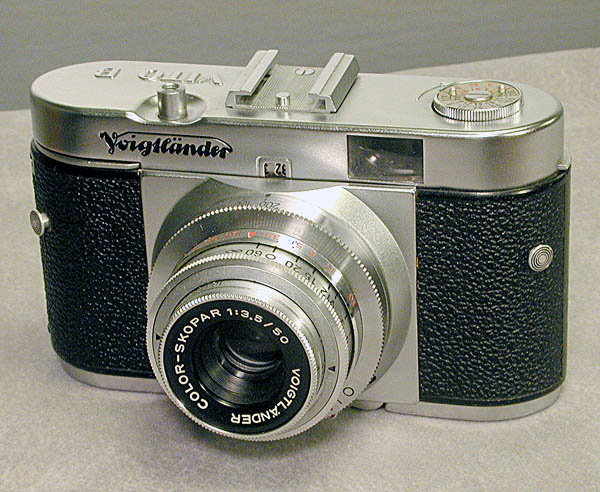
The Voigtländer Vito B with which my father took my baby pictures;
still in good working order. Not a full-featured camera — no rangefinder,
no light meter, only 4 shutter speeds — but ruggedly built, with a very sharp lens.
Pacific Rim Camera has a huge set of camera-collecting web pages and links to
information elsewhere. From them I've learned that my camera collection (accumulation? junkpile?)
has been appreciating rapidly over the last few years.
Now that film photography is definitely being replaced by digital,
somehow the old film cameras have become more desirable, not less.
And it no longer seems to matter whether they work.
Nobody is introducing new high-end film cameras except
the extreme traditionalists at Zeiss.
Their latest offering strikes me as the hot new camera of 60 years ago.
More exciting is cameraquest.com, with lots of
out-of-the-way information about lenses and lens mount adapters.
Voigtländer lenses for Olympus OM? Somehow they were off my radar back when I was
using Olympuses. But they seem to be classic Zeiss Ikon Voigtländer designs... Hmmm again.
Anyone who is serious about using old cameras is likely to end up wanting to
do his own repairs. I've done some but am not an expert.
It's very time-consuming and somewhat risky.
Permanent link to this entry


|

|
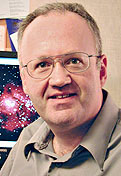









 Abolish the penny?
Yes, please! It's been obsolete for half a century.
Keep it around in small quantities for people who want it, but pass a law allowing all cash
transactions to be rounded to the nearest 5 cents.
Lots of other countries have done similar things.
Today's dime, not penny, is worth what the half-cent was worth when we
discontinued
Abolish the penny?
Yes, please! It's been obsolete for half a century.
Keep it around in small quantities for people who want it, but pass a law allowing all cash
transactions to be rounded to the nearest 5 cents.
Lots of other countries have done similar things.
Today's dime, not penny, is worth what the half-cent was worth when we
discontinued  This particular Coolscan is a SCSI device and is a bit tricky to get working
under Windows XP.
Here's what I know...
This particular Coolscan is a SCSI device and is a bit tricky to get working
under Windows XP.
Here's what I know...


 Today Nikon surprised the world by introducing a new, low-priced DSLR camera,
Today Nikon surprised the world by introducing a new, low-priced DSLR camera,








